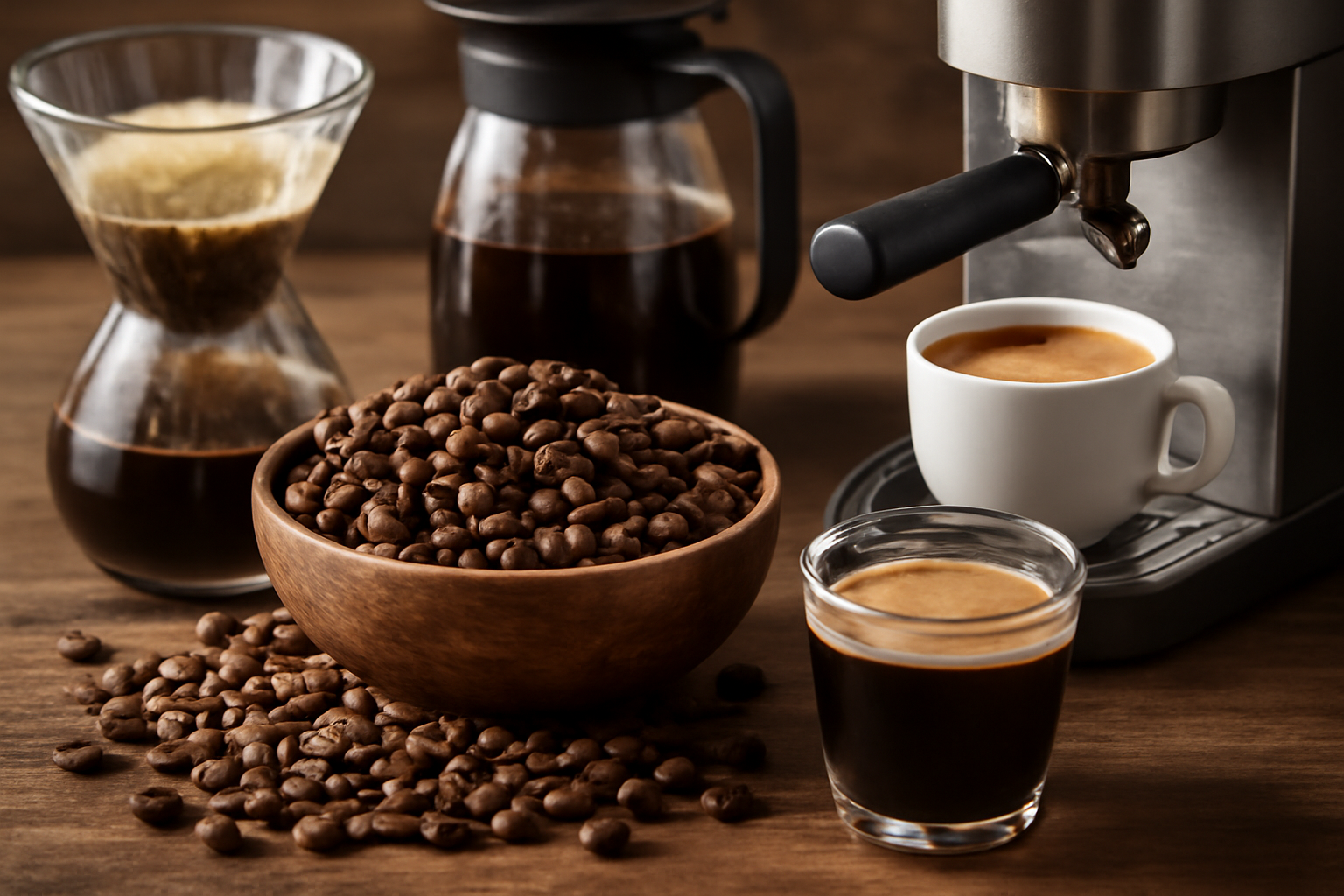Coffee is more than just a drink; it’s a ritual, a passion, and an art form. Whether you’re brewing your morning cup at home or perfecting your technique as a barista, the choice of coffee bean plays a vital role in achieving the best flavor. From the subtle sweetness of an Arabica bean to the bold bitterness of Robusta, the type of coffee you choose will drastically change the final cup.
But with the overwhelming variety of coffee beans available, how can you ensure that you’re choosing the right one for your brewing method? In this guide, we’ll dive deep into understanding the different types of coffee beans and provide insight into how to match them with your brewing method for the best experience possible. Whether you’re new to the world of coffee or a seasoned coffee connoisseur, this article will help you elevate your brewing game.
The Basics of Coffee Beans
Before we get into specific brewing methods, let’s first explore the three primary types of coffee beans you’ll encounter. Understanding these beans is the first step in finding the right one for your cup.
1. Arabica Beans
Arabica beans, scientifically known as Coffea arabica, are the most popular and highly prized coffee beans in the world. They account for about 60-70% of global coffee production. Arabica beans are known for their smooth, mild flavor, balanced acidity, and aromatic profile. These beans are typically grown at higher altitudes in regions such as Ethiopia, Colombia, and Brazil.
The flavor profile of Arabica coffee is rich and complex, often exhibiting subtle notes of fruit, florals, and even hints of chocolate or caramel. The acidity in Arabica beans tends to be bright but not overpowering, which is why these beans are commonly used for pour-over, drip coffee, and espresso.
2. Robusta Beans
Robusta beans, Coffea canephora, are the second most common type of coffee bean. While Arabica beans are known for their smoothness, Robusta beans are more bitter, contain more caffeine, and have a stronger flavor. They are often used in espresso blends for their ability to provide rich crema and robust body.
Robusta beans are typically grown at lower altitudes in regions such as Vietnam, Uganda, and Indonesia. They have a much stronger, earthier taste compared to Arabica, with a flavor profile that can include wood, nuts, and sometimes even a slight rubbery or astringent note. Robusta beans are often cheaper than Arabica, making them a popular choice for mass-market coffee and instant coffee.
3. Liberica and Excelsa Beans
Liberica and Excelsa beans are less common but are still part of the coffee bean family. They are known for their distinct, unique flavors, making them sought-after by coffee enthusiasts who are looking for something different.
- Liberica: These beans have a distinctive smoky, woody flavor, often compared to a fruity and floral profile with hints of spices. They are commonly found in Southeast Asia, especially in the Philippines and Malaysia.
- Excelsa: A variety of Liberica, Excelsa beans are known for their complex and bold flavors. They often have fruity and tangy notes, making them ideal for blending to add a unique twist to coffee.
These beans are not as widely available as Arabica or Robusta, but they are used in some specialty coffee blends and can create a truly unique coffee experience.
Choosing the Right Coffee Bean Based on Brewing Method
Each brewing method has its own set of requirements for the type of coffee bean it works best with. Below, we’ll explore the most popular brewing methods and explain which types of beans and roasts are best suited for each.
1. Espresso
Espresso is one of the most popular methods for brewing strong, concentrated coffee. The coffee is brewed under high pressure, producing a rich, full-bodied shot with a layer of crema on top.
For espresso, Arabica beans are often preferred because they produce a balanced, smooth flavor. A dark roast or medium-dark roast is ideal for creating that classic espresso flavor. These roasts bring out the rich, chocolatey, and nutty flavors that espresso lovers enjoy. The fine grind size of espresso requires a precise amount of time for water to pass through the grounds, so selecting beans with a flavor profile that complements this method is essential.
If you prefer a bolder espresso, adding Robusta beans to your espresso blend can enhance the crema and increase the caffeine content. Robusta beans provide a thicker crema and give the espresso a more intense, somewhat bitter taste.
2. Drip Coffee
Drip coffee, also known as filtered coffee, is one of the most common brewing methods. The coffee grounds are placed in a filter, and water is slowly poured over them, dripping through to create a smooth, clean cup.
For drip coffee, medium roasts are often the best choice. A medium roast brings out the natural flavors of the beans while maintaining a balanced acidity. Arabica beans work particularly well for this brewing method due to their complex flavors and mild acidity. Light roasts can also be used if you prefer a brighter, more acidic cup.
It’s important to choose a coffee that is freshly roasted, as freshness will have a significant impact on the flavor. Additionally, grind your coffee to a medium coarseness to ensure an even extraction.
3. French Press
The French Press brewing method allows coffee to steep in water for several minutes, resulting in a full-bodied, rich cup of coffee. This method works particularly well with a coarser grind, which prevents over-extraction and creates a thick, flavorful brew.
For the French Press, medium to dark roasts are ideal. Darker roasts enhance the bold, rich flavors of coffee, which are important for a French Press brew. Arabica beans work wonderfully here, providing a smooth yet bold taste, while Robusta beans can add a stronger body and flavor if you want a more intense cup.
Experimenting with different roast levels and blends can help you find the perfect balance of richness and smoothness for your French Press coffee.
4. Pour-Over (e.g., Chemex, V60)
Pour-over coffee offers a clean, bright cup with an emphasis on the delicate flavors of the coffee. This method involves pouring hot water over coffee grounds in a filter, allowing the water to extract the coffee slowly.
For pour-over coffee, light to medium roasts are generally the best choice. Light roasts, in particular, preserve the complex flavors and fruity notes of the coffee beans. Arabica beans are often favored for pour-over brewing due to their nuanced and aromatic flavors. A medium grind is ideal for pour-over brewing, allowing for an even extraction that highlights the coffee’s intricate taste profile.
If you prefer a coffee with more acidity and clarity, opt for a lighter roast. If you enjoy a smoother, more balanced cup, go for a medium roast.
5. Cold Brew
Cold brew coffee is made by steeping coarsely ground coffee in cold water for an extended period (typically 12 to 24 hours). This method produces a smooth, low-acid, and slightly sweeter coffee.
For cold brew, medium to dark roasts are the most suitable. Darker roasts work well because their robust flavors can withstand the long steeping time. Arabica beans with notes of chocolate and caramel are often the best choice for cold brew, as they create a smooth, sweet, and easy-to-drink coffee.
It’s also important to use a coarse grind for cold brew to prevent over-extraction and ensure a clean, smooth cup.
The Role of Freshness in Coffee Beans
Freshness is key to unlocking the full potential of your coffee beans. Coffee begins to lose its flavor shortly after it’s roasted, and ground coffee loses its aroma and taste even more quickly. To ensure that you’re brewing the best cup possible, follow these tips:
- Buy Whole Beans: Purchase whole coffee beans and grind them just before brewing. This ensures that the oils and flavors are retained.
- Store Properly: Store your coffee beans in an airtight container, away from light, heat, and moisture. A cool, dark place is ideal.
- Use Within Two Weeks: Try to consume your coffee within two weeks of roasting to experience the freshest flavor.
Conclusion: Finding Your Perfect Coffee Bean
Choosing the best coffee bean for your brewing method is a combination of art and science. The right beans will enhance the flavor of your coffee and elevate your brewing experience. Experiment with different beans, roasts, and brewing methods to discover what works best for you.
Remember, coffee is a personal experience. There’s no one-size-fits-all answer, but by understanding the different types of beans and how they interact with various brewing methods, you can begin to create the perfect cup every time. So, whether you’re making espresso, pour-over, or cold brew, take the time to select the right coffee beans, and you’ll enjoy a brew that’s truly exceptional.

I’m an economist with 15 years of experience in strategic planning and a lifelong passion for wellness and natural living. As a self-learner, I created Herbalife Balance to share insights on healthy eating, mindful habits, and an active lifestyle. Tennis enthusiast and nature lover, I believe in balance as a path to well-being. Through this blog, I help others live healthier, more conscious lives.

